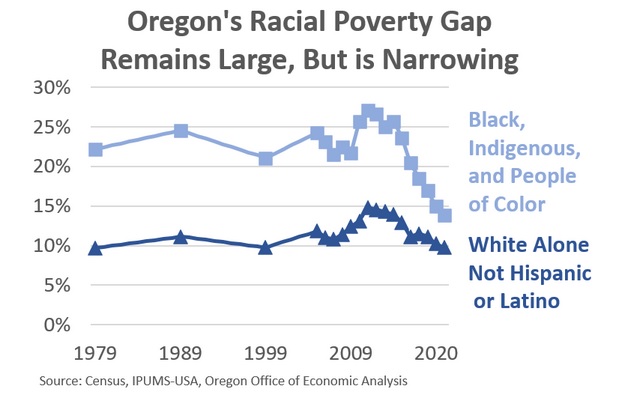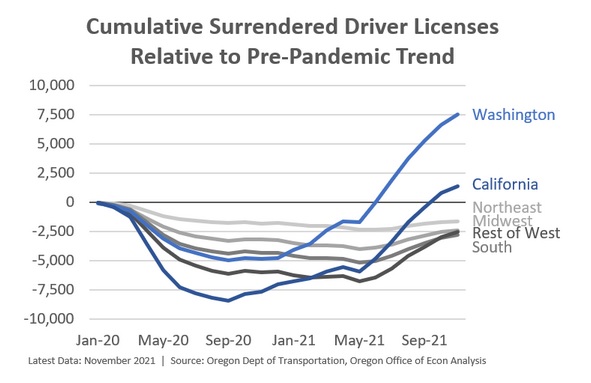
By Josh Lehner,
Oregon office of Economic Analysis,
First, Kanhaiya Vaidya, the state demographer in our office, crunched some of the 2020 ACS microdata data for poverty rates by race and ethnicity. In a less diverse state we know the sample sizes can be small and the data noisy, even in years when Americans actually filled out the surveys. 2020 was not a good data collection year. With that caveat said, broadly speaking the data show that the racial poverty gap continued to narrow.
There were some noticeable increases seen in the data for Black, and American Indian and Alaska Native Oregonians. It can be hard to know today how much of the increases are real versus noise, but this is something our office keeps a close eye on every where when the data is released. Now, there were some larger decreases seen in the data for Asian and Pacific Islander Oregonians, and those identifying as two or more races. Additionally poverty declined noticeably for Hispanic or Latino Oregonians. Somewhat smaller declines were seen for White, non-Hispanic Oregonians. Overall, the racial poverty gap stood at 4.0 percentage points in 2020, the smallest on record. See our previous post for more on statewide income and poverty trends.
Second, we know there has been no pandemic-related migration boom in Oregon. However, our office’s forecast expects migration to pick up today and in the years ahead. One question we get is why do we think that will happen? One reason is we know historically migration has been pro-cyclical. The economy is now on the upswing, and job opportunities are plentiful. Young, working-age types are always the most likely to move and so expectations are some of them will move here, like they usually do.
Another reason we believe there will be an acceleration in migration is our best leading indicator has already turned up as well. The number of surrendered driver licenses are now essentially back to pre-pandemic trend overall, with migration from our neighboring states now above trend. Any weakness is coming from longer distance moves.
Now, due to the pandemic, and shutdowns, and appointment-only DMVs for a time the driver license data was not as informative as it usually is. There is a risk that continues to be the case, and we know some of the pick up in surrendered driver licenses is just catch up for those who moved during the pandemic and didn’t get an Oregon license in short order. But the broader trends certainly appear to be intact. Migration is picking up. This is a key driver for Oregon’s above-average economic growth over the full business cycle.
Disclaimer: Articles featured on Oregon Report are the creation, responsibility and opinion of the authoring individual or organization which is featured at the top of every article.



